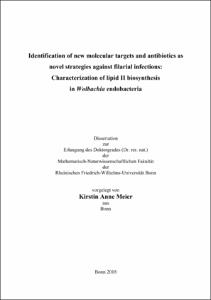Identification of new molecular targets and antibiotics as novel strategies against filarial infectionsCharacterization of lipid II biosynthesis in Wolbachia endobacteria

Identification of new molecular targets and antibiotics as novel strategies against filarial infections
Characterization of lipid II biosynthesis in Wolbachia endobacteria

| dc.contributor.advisor | Hörauf, Achim | |
| dc.contributor.author | Meier, Kirstin Anne | |
| dc.date.accessioned | 2020-04-26T13:56:24Z | |
| dc.date.available | 2020-04-26T13:56:24Z | |
| dc.date.issued | 05.06.2019 | |
| dc.identifier.uri | https://hdl.handle.net/20.500.11811/7937 | |
| dc.description.abstract | Wolbachia are obligate intracellular bacteria found in many arthropods and some filarial nematodes that are pathogenic in humans. The Wolbachia genomes are highly reduced, but encode proteins required for the synthesis of the peptidoglycan precursor lipid II. Recombinant proteins and purified Wolbachia membranes synthesize lipid I and II and these cell wall precursors are essential for Wolbachia cell division. It is unclear how lipid II is further processed and a peptidoglycan-like structure has not been detected. To provide insight into wolbachial lipid II processing, the putative penicillin-binding proteins (PBPs) PBP2 and PBP6a from Wolbachia endosymbionts of the filarial nematode Brugia malayi (wBm) were analyzed in this study. Also, the activity of AmiD and PBP3 from Wolbachia endosymbionts of Drosophila melanogaster (wMel) were characterized, two lipid II processing enzymes additionally present in genomes of Wolbachia residing in arthropods. Binding studies were performed to measure a potential interaction between the peptidoglycan-associated outer membrane lipoprotein (Pal) from wBm and lipid II as well as PBP2. To detect a putative peptidoglycan-like structure in Wolbachia, lipid II was labeled in Wolbachia from Aedes albopictus using dipeptide analogues. Moreover, an established cell-free Wolbachia culture was further studied regarding potential growth facilitating factors and impact of antibiotics. The results of the present study demonstrate PBP activity in dependence on functional serines of the active site motifs SXXK. PBPs are typically blocked by β-lactam antibiotics that bind to the serine of the highly conserved SXXK motif. Nevertheless, the PBPs were resistant to β-lactams. Contrary to their E. coli orthologs, all examined wolbachial PBPs encode additional SXXK motifs which might contribute to enzyme functionality and might explain β-lactam resistance. In silico analyses predicted that due to protein folding, β-lactams might not have access to all active site motifs. Therefore, in contrast to canonical systems like E. coli, these enzymes are not appropriate targets to deplete Wolbachia. AmiD showed zinc-dependent amidase activity and cleaved intact peptidoglycan, monomeric lipid II and additionally anhydromuropeptides, substrates that are generated by cleaved glycosidic bonds of glycan strands. The conservation of the capability of AmiD to cleave anhydromuropeptides gives a hint that at least insect Wolbachia may contain a peptidoglycan-like structure with connected glycan strands. Lipid II and PBP2 both interacted with the outer membrane protein Pal from wBm suggesting that lipid II and PBP2 are present in the Wolbachia periplasmic space. These results together with the active PBPs from wBm indicate that lipid II might be processed to a peptidoglycan-like structure also in Wolbachia residing in filarial nematodes. The dipeptide labeling provided visual evidence of a lipid II- containing structure in Wolbachia for the first time, which was absent in fosfomycin-treated cells with impaired lipid II synthesis. Moreover, fosfomycin led to an aberrant phenotype of cell-free Wolbachia resulting in enlarged cells. None of the other applied antibiotics including β- lactams showed an effect on morphology providing further evidence that Wolbachia are resistant to this class of antibiotics. In conclusion, the results of this study together with latest research findings regarding peptidoglycan in intracellular bacteria indicate that Wolbachia are not cell wall-less bacteria, but rather have a physical structure composed of lipid II that can interact with outer membrane proteins and that is necessary for coordinated cell division. | |
| dc.language.iso | eng | |
| dc.rights | In Copyright | |
| dc.rights.uri | http://rightsstatements.org/vocab/InC/1.0/ | |
| dc.subject | Zellwand | |
| dc.subject | Peptidoglykan | |
| dc.subject | Penicillin-bindende Protein | |
| dc.subject | Wolbachien | |
| dc.subject | Filariose | |
| dc.subject | cell wall | |
| dc.subject | peptidoglycan | |
| dc.subject | penicillin-binding proteins | |
| dc.subject | Wolbachia | |
| dc.subject | filariasis | |
| dc.subject.ddc | 570 Biowissenschaften, Biologie | |
| dc.subject.ddc | 610 Medizin, Gesundheit | |
| dc.title | Identification of new molecular targets and antibiotics as novel strategies against filarial infections | |
| dc.title.alternative | Characterization of lipid II biosynthesis in Wolbachia endobacteria | |
| dc.type | Dissertation oder Habilitation | |
| dc.publisher.name | Universitäts- und Landesbibliothek Bonn | |
| dc.publisher.location | Bonn | |
| dc.rights.accessRights | openAccess | |
| dc.identifier.urn | https://nbn-resolving.org/urn:nbn:de:hbz:5n-54822 | |
| ulbbn.pubtype | Erstveröffentlichung | |
| ulbbnediss.affiliation.name | Rheinische Friedrich-Wilhelms-Universität Bonn | |
| ulbbnediss.affiliation.location | Bonn | |
| ulbbnediss.thesis.level | Dissertation | |
| ulbbnediss.dissID | 5482 | |
| ulbbnediss.date.accepted | 06.05.2019 | |
| ulbbnediss.institute | Medizinische Fakultät / Institute : Institut für Medizinische Mikrobiologie, Immunologie und Parasitologie (IMMIP) | |
| ulbbnediss.fakultaet | Mathematisch-Naturwissenschaftliche Fakultät | |
| dc.contributor.coReferee | Haas, Albert |
Dateien zu dieser Ressource
Das Dokument erscheint in:
-
E-Dissertationen (4077)




